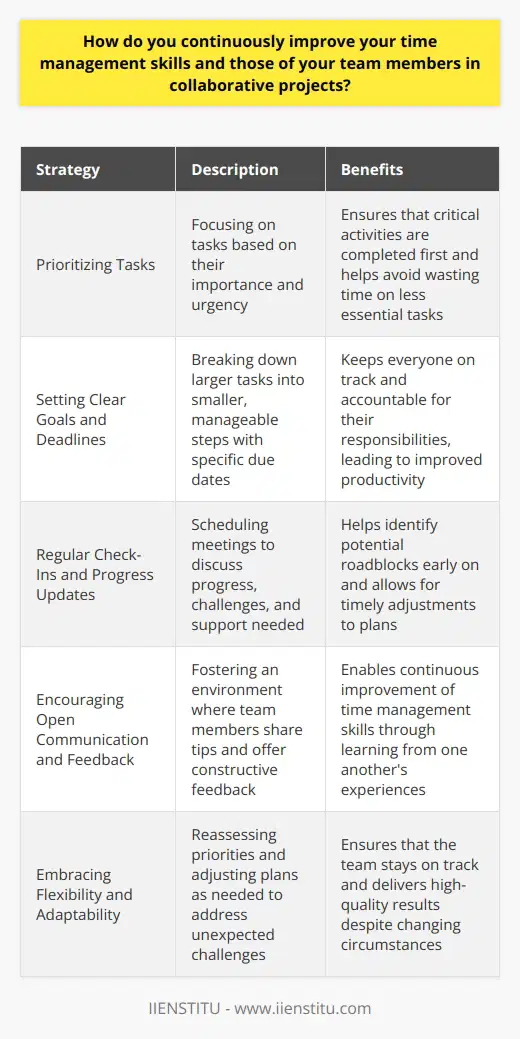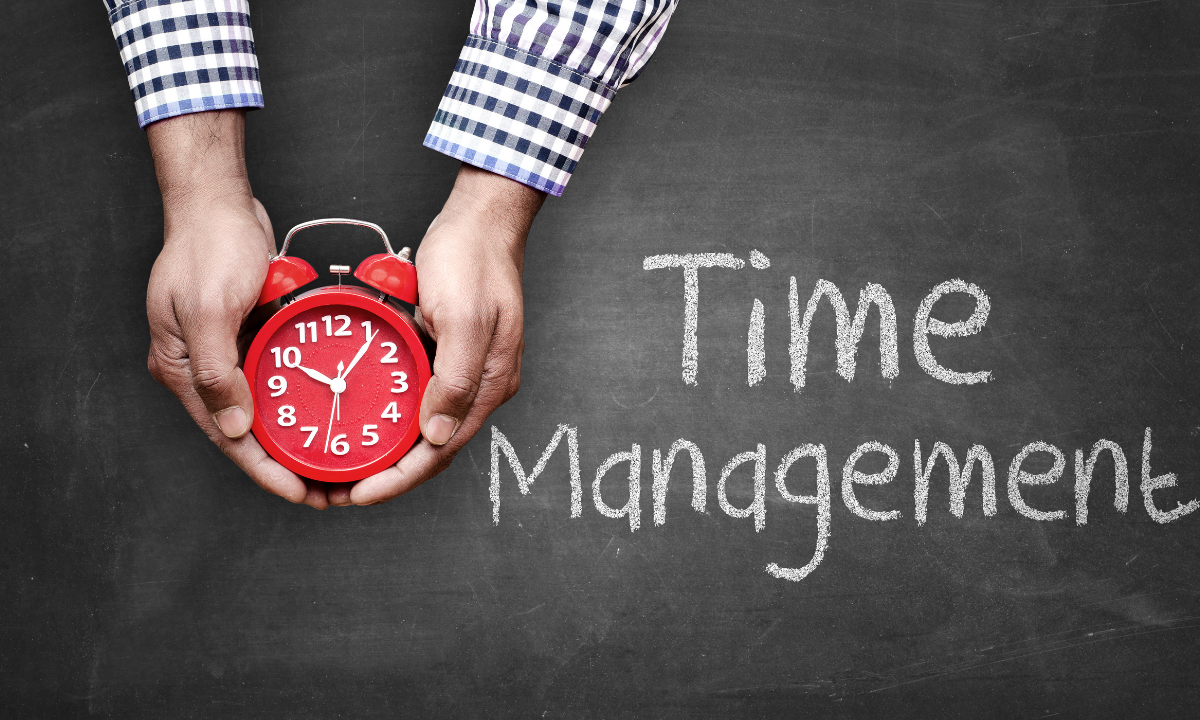
Few questions are as integral to the successful operation of a workspace as "How do you handle time management in collaborative projects?" This seemingly straightforward question emerges in almost every interview for roles that require a mix of team collaboration and effective time management.
Related Course: Time Management Free Online Course
The query's frequency underlines the importance of displaying a candidate's competency in successfully navigating the intricacies of time management, especially in the realm of collaborative work.
Why is this Interview Question Asked: How Do You Handle Time Management in Collaborative Projects?
Understanding the "why" behind this common yet crucial question is central. In the realm of collaborative projects, time management is a non-negotiable requirement. Employers ask this question to examine your mindset on teamwork, your strategies for handling diverse tasks, and your proficiency in organizing your workload effectively.
In essence, "How do you handle time management in collaborative projects?" is an opportunity for you, as a candidate, to sell your skills and experiences. It shines a spotlight on your abilities to work synergistically within a team while maintaining high efficiency standards.
The Purpose of The Question
This question serves two major objectives. The first is to test your ability to efficiently utilize time, while the second is to evaluate your functionality within a team setting. Both aspects play a pivotal role in driving productivity within a workspace.
Highly professional environments often demand work on collaborative projects, where the dynamics of time management can fluctuate significantly. Your response provides employers with a snapshot of your adaptability amid shifting tasks, priorities and deadlines, which are par for the course in collaborative work.
Interview Question: What Time Management Technique Starts Your Day?
Interview Question: How Do You Balance Personal and Work Time Management?
Interview Question: Measuring Performance with Supply Chain KPIs
At What Interview Level is It Asked?
The question transcends the interview hierarchy. Be it an entry-level applicant or a seasoned professional vying for a managerial role, everyone needs to demonstrate their capabilities in managing time effectively in collaborative scenarios.
By probing into this topic, interviewers can surmise your skills and strategies, irrespective of your career stage.
What Kind of Answer is Expected from the Candidate?
The answer to "How do you handle time management in collaborative projects?" should reflect a candidate's aptitude for planning, organizing, and prioritizing tasks in collaboration with others. Ideally, concrete examples from past experiences will illustrate your ability to meet deadlines and excel as a team player.
Your response should showcase your proficiency in using technological tools for time management, ability to multitask, set smart goals and maintain flexibility in changing situations. Avoid providing generic answers. Instead, focus on highlighting your unique skills and experiences to stand out from the crowd.
Possible Answers to Consider
A model reply could include your diligent utilization of scheduling and planning tools, strategy for prioritizing tasks based on urgency, and ability to maintain regular communication with team members. You could say something like,
"In previous projects, I effectively used tools like Asana or Trello to stay organized. Regular communication and breaking down the project into manageable components were key. Each task was tagged with an urgency level, helping me prioritize accordingly."
You could also showcase your ability to adapt in changing situations. For instance,
"In my last role, we faced an unexpected issue that required us to re-plan our entire project timeline. I initiated a team discussion where we reassessed our duties, reset priorities and implemented a new timeline. By maintaining our flexibility, we successfully completed the project two days under our revised deadline."
Your ability to manage "time" in "team" is a testament to your professional capabilities. "How do you handle time management in collaborative projects?" offers you the platform to illustrate just that. So seize the moment, share your tried-and-tested strategies and let the employer know how your skills make you an ideal candidate for their team.
Strategies for Distributing Tasks in Collaborative Projects
An Overview of Various Aspects Related to Time Management in Collaborative Projects
Tools Utilized for Time Management in Collaborative Projects
Similar interview questions:
What strategies do you use to manage time in collaborative projects?
Can you describe your experience with time management in team projects?
How do you schedule tasks to ensure efficient time management in a team setting?
What processes do you implement to ensure effective time management in a collaborative project?
What techniques do you find most effective for handling time management during collaborations?
When leading a team, how do you organize the tasks to manage time effectively?
How do you delegate responsibilities to keep things on schedule in a collaborative project?
How do you avoid time mismanagement when working collaboratively on a project?
How do you overcome delays and avoid time wastage during team projects?
In what ways do you ensure that time is managed efficiently in a collaborative project scenario?

Frequently Asked Questions
How do you prioritize tasks when working on a team project?
When working on a team project, I prioritize tasks based on their importance and urgency. I consider the project timeline, dependencies, and the impact of each task on the overall project success.
Communicating with the Team
I believe in clear communication with my team members. We discuss the project goals, deliverables, and deadlines. This helps me understand the bigger picture and how my tasks fit into it.
Breaking Down Tasks
I break down larger tasks into smaller, manageable chunks. This allows me to focus on one thing at a time and make steady progress. I set personal milestones and deadlines to stay on track.
Prioritizing Based on Impact
I prioritize tasks that have the highest impact on the project's success. These are typically tasks that are critical to moving the project forward or those that other team members are waiting on.
Staying Flexible
While I have a plan, I also remain flexible. Priorities can shift based on new information or changes in the project. I adapt my task list accordingly and communicate any changes with my team.
In my previous role, I worked on a website redesign project. I prioritized tasks like wireframing and content creation that set the foundation for the rest of the project. As the project progressed, I adjusted my priorities to ensure we launched on time.
Ultimately, effective prioritization comes down to understanding the project goals, communicating with the team, and staying organized. It's a skill I've developed over time and one that I continue to refine with each new project.

What strategies do you use to meet deadlines in a collaborative environment?
In a collaborative environment, I use several strategies to meet deadlines effectively. First, I prioritize tasks based on their urgency and importance. This helps me focus on the most critical tasks and ensures that I allocate my time wisely.
Communication is Key
I believe that open and clear communication is essential for meeting deadlines in a team setting. I make sure to communicate regularly with my colleagues, providing updates on my progress and seeking clarification when needed. This helps prevent misunderstandings and ensures that everyone is on the same page.
Breaking Down Tasks
Another strategy I employ is breaking down larger tasks into smaller, manageable chunks. By doing this, I can track my progress more easily and identify any potential roadblocks early on. It also allows me to collaborate with my teammates more effectively, as we can divide the work based on our strengths and expertise.
Staying Organized
Staying organized is crucial when working towards deadlines. I use project management tools like Trello or Asana to keep track of tasks, deadlines, and responsibilities. This helps me stay on top of my work and ensures that nothing falls through the cracks.
Flexibility and Adaptability
Finally, I believe that being flexible and adaptable is essential in a collaborative environment. Sometimes, unexpected challenges arise, and priorities shift. When this happens, I remain open to adjusting my approach and working with my team to find solutions. By being adaptable, I can ensure that we meet our deadlines, even in the face of adversity.

How do you ensure effective communication among team members to manage time efficiently?
Effective communication is crucial for managing time efficiently within a team. I always strive to be clear and concise when conveying information to my colleagues.
Regular Check-Ins
I believe in the power of regular check-ins with team members. When I worked on a tight deadline project last year, I made sure to touch base with each person daily. These brief meetings allowed us to stay aligned, identify roadblocks, and brainstorm solutions together.
Active Listening
Active listening is another key aspect of effective communication. I give my full attention when a team member is speaking and ask clarifying questions to ensure understanding. This helps prevent misunderstandings that could waste valuable time.
Leveraging Technology
I'm a big fan of using technology to streamline communication. Tools like Slack and Asana have been game-changers for me in terms of keeping everyone on the same page. I create dedicated channels for each project so all relevant information is easily accessible.
Encouraging Open Dialogue
Finally, I believe in fostering an environment where team members feel comfortable speaking up. I encourage my colleagues to share their ideas, concerns, and feedback openly. When everyone feels heard and valued, collaboration flows more smoothly, and we can make the most of our time together.
By implementing these strategies consistently, I've been able to ensure effective communication within my teams. The result is always more efficient time management and successful project outcomes.

Can you describe a time when you had to manage conflicting priorities in a group project?
In my previous job as a marketing coordinator, I had to manage conflicting priorities during a product launch. The design team was behind schedule, but the sales team needed the brochures immediately.
Assessing the Situation
I quickly assessed the situation and realized that a compromise was necessary. I met with both teams to understand their needs and constraints. Through open communication, we found a middle ground.
Prioritizing and Delegating
I prioritized the most essential brochure elements for the sales team's immediate use. I delegated the remaining tasks to the design team, setting clear expectations and deadlines. This approach allowed us to meet the sales team's needs while giving the design team more time.
Leveraging Technology
To streamline the process, I suggested using collaborative design software. This allowed the teams to work together in real-time, reducing back-and-forth and speeding up revisions.
Keeping Everyone Informed
Throughout the project, I kept all stakeholders informed of progress and changes. Regular updates helped maintain transparency and trust. When challenges arose, I communicated proactively to find solutions.
Successful Outcome
By managing conflicting priorities effectively, we delivered the brochures on time for the product launch. The sales team had the tools they needed, and the design team produced high-quality work. This experience taught me the importance of communication, compromise, and adaptability in managing competing demands.
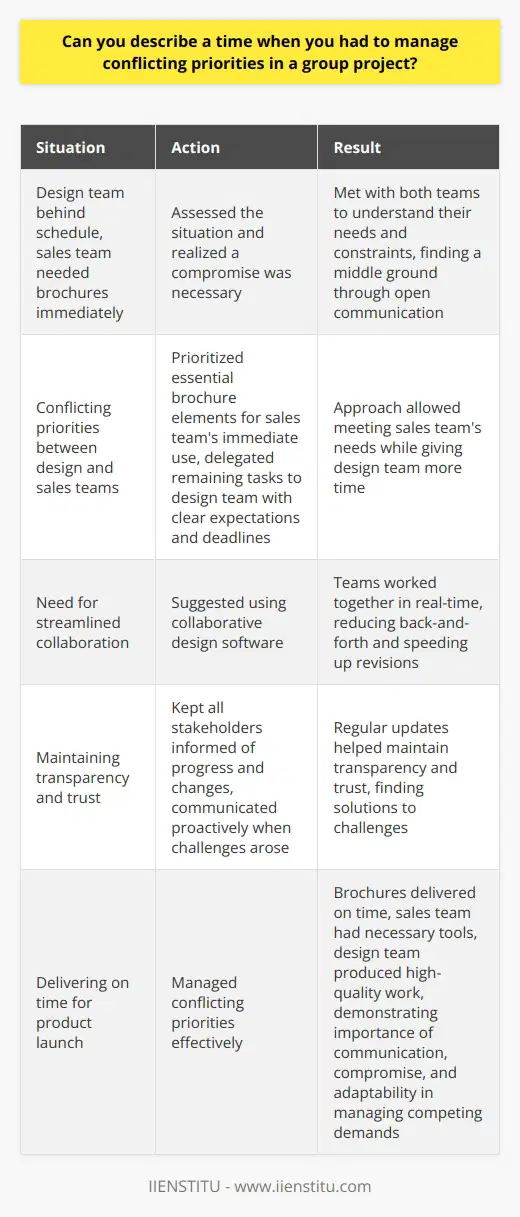
What tools or techniques do you use to keep track of progress and timelines in collaborative projects?
When working on collaborative projects, I rely on a combination of tools and techniques to stay organized and on track. One of my go-to tools is Trello, a user-friendly project management platform that allows me to create boards for each project, break them down into tasks, and assign responsibilities to team members. I love how visual and intuitive it is, making it easy to see progress at a glance.
Regular check-ins and communication
In addition to using project management software, I believe that regular check-ins and communication with team members are crucial. I make it a point to touch base with my colleagues at least once a week, either through quick stand-up meetings or via messaging apps like Slack. These interactions help us stay aligned, address any roadblocks, and ensure we're all moving in the same direction.
Setting clear milestones and deadlines
Another technique I find effective is setting clear milestones and deadlines for each phase of the project. By breaking down the work into smaller, manageable chunks, it becomes less overwhelming and easier to track progress. I like to use Google Calendar to set reminders for key dates and share them with the team, so everyone is aware of the timeline we're working towards.
Adapting to changing priorities
Of course, even with the best-laid plans, things can change unexpectedly. That's why I believe in being flexible and adaptable. If priorities shift or new challenges arise, I work with my team to reassess our timeline and adjust our approach as needed. It's all about staying agile and finding creative solutions to keep the project moving forward.
At the end of the day, the key to successful collaborative projects is open communication, trust, and a shared commitment to the end goal. By leveraging the right tools and techniques, and fostering a strong team dynamic, I've found that even the most complex projects can be managed effectively and delivered on time.

How do you handle situations where a team member is not meeting their deadlines?
In situations where a team member is not meeting their deadlines, I take a proactive and supportive approach. My first step is to have an open and honest conversation with the team member to understand the reasons behind the missed deadlines.
Identifying the Root Cause
During this discussion, I actively listen to their concerns and challenges. Together, we identify the root cause of the problem, whether it's a lack of resources, unclear expectations, or personal difficulties.
Developing a Plan of Action
Once we have a clear understanding of the situation, we collaborate to develop a plan of action. This may involve breaking down the tasks into smaller, manageable steps, setting realistic milestones, and providing additional support or resources if needed.
Offering Guidance and Support
Throughout the process, I offer guidance, mentorship, and encouragement to help the team member get back on track. I make myself available for regular check-ins to monitor progress and address any obstacles that may arise.
I remember one instance where a colleague was struggling to meet deadlines due to personal issues. By extending empathy and working together to redistribute some of their workload temporarily, we were able to help them regain their footing and contribute effectively to the team's goals.
Fostering a Supportive Team Environment
Ultimately, my goal is to foster a supportive and collaborative team environment where everyone feels comfortable seeking help when needed. By addressing challenges proactively and compassionately, we can ensure that all team members are set up for success and can contribute their best work to the project.

Can you give an example of how you have successfully managed your time in a past collaborative project?
In my previous role as a project manager, I successfully managed my time in a collaborative project by prioritizing tasks and delegating responsibilities effectively. I created a detailed project timeline with specific milestones and deadlines for each team member.
Communicating Regularly
I scheduled regular check-ins with the team to monitor progress and address any challenges or roadblocks. These meetings helped ensure everyone was on the same page and working towards our common goals.
Using Project Management Tools
To stay organized, I utilized project management software like Trello and Asana. These tools allowed me to assign tasks, track progress, and collaborate seamlessly with my teammates.
Adapting to Changes
Throughout the project, unexpected issues arose that required me to adjust our timeline and resources. By remaining flexible and proactive, I was able to adapt our plan and keep the project moving forward.
Celebrating Milestones
To maintain team morale and motivation, I made sure to celebrate our successes along the way. Recognizing the hard work and achievements of my colleagues helped foster a positive and productive work environment.
The End Result
Thanks to effective time management and collaboration, we delivered the project on schedule and exceeded our client's expectations. It was a challenging but rewarding experience that taught me valuable lessons about leadership and teamwork.
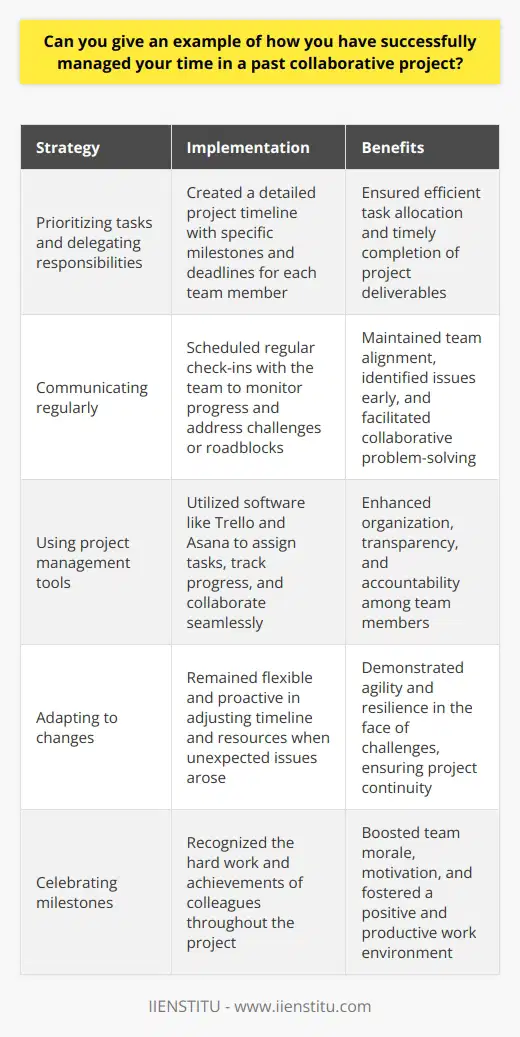
How do you balance your individual tasks with the overall project timeline in a team setting?
When balancing individual tasks with the overall project timeline in a team setting, I prioritize communication and collaboration. I regularly check in with my teammates to ensure we're all on the same page and working towards our shared goals.
Staying Organized
I keep myself organized with to-do lists and calendars. This helps me stay on top of my individual responsibilities while being mindful of the bigger picture. If I notice my tasks are taking longer than expected, I let my team know right away so we can adjust our timeline if needed.
Offering Support
When I finish my own work ahead of schedule, I always ask my teammates if they need any help. We succeed together, so I'm happy to lend a hand however I can. It's a great feeling when we all pull together to get the job done!
Adapting to Changes
I've learned that timelines don't always go according to plan, and that's okay. The key is staying flexible. If priorities shift or unexpected challenges pop up, I quickly adapt so I can keep contributing to the team's overall progress.
Trusting My Team
At the end of the day, balancing individual and team responsibilities comes down to trust. I trust my colleagues to do their part, and they can count on me to deliver quality work on time. When everyone operates with that mindset, it's amazing what we can accomplish together.

What methods do you use to break down a large project into manageable tasks for yourself and your team members?
When tackling a large project, I break it down into smaller, manageable tasks. This approach helps me and my team members stay focused and motivated throughout the project.
Identifying Project Goals and Milestones
I start by clearly defining the project's goals and key milestones. This helps me create a roadmap for the entire project and ensures that everyone is on the same page.
Creating a Work Breakdown Structure
Next, I develop a work breakdown structure (WBS). The WBS allows me to divide the project into smaller, more manageable components. Each component represents a specific task or deliverable.
Assigning Tasks and Deadlines
I assign tasks to team members based on their skills and experience. I also set realistic deadlines for each task, considering the project's overall timeline and any dependencies between tasks.
Monitoring Progress and Adjusting as Needed
Throughout the project, I closely monitor progress and make adjustments as needed. Regular check-ins with team members help me identify any issues or roadblocks early on, so we can address them quickly.
I've found that this approach keeps everyone accountable and ensures that we're making steady progress towards our goals. It also helps prevent overwhelm and burnout, as team members can focus on one task at a time.
In my previous role, I used this method to successfully manage a complex software development project. By breaking the project down into smaller tasks and assigning them to team members based on their strengths, we were able to deliver the project on time and within budget.
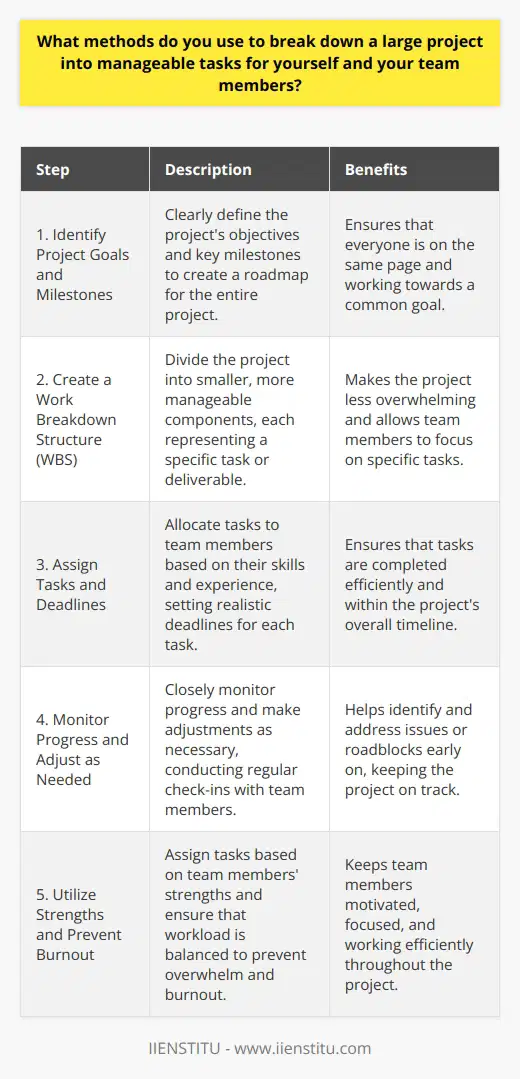
How do you ensure that everyone in the team is aware of their responsibilities and deadlines?
As a team leader, I believe that clear communication and well-defined expectations are key to ensuring everyone understands their responsibilities and deadlines. Here are some strategies I use:
Regular Team Meetings
I schedule weekly team meetings where we discuss ongoing projects, assign tasks, and clarify any questions or concerns. These meetings provide an opportunity for everyone to get on the same page and understand their individual roles in achieving our goals.
Project Management Tools
I utilize project management software like Trello or Asana to create task lists, set deadlines, and track progress. These tools allow team members to see their assigned tasks, due dates, and any dependencies or collaborations required.
One-on-One Check-Ins
In addition to team meetings, I schedule regular one-on-one check-ins with each team member. These conversations allow me to provide individualized guidance, answer questions, and ensure they have the resources and support needed to meet their deadlines.
Clear Documentation
I create detailed project plans, timelines, and task descriptions that outline expectations and deliverables. By providing clear documentation, team members can reference their responsibilities and deadlines at any time, reducing confusion and miscommunication.
Encouraging Open Communication
I foster an environment of open communication where team members feel comfortable asking questions, seeking clarification, and raising concerns. By promoting a culture of transparency and collaboration, we can quickly address any issues or roadblocks that may impact deadlines.
By implementing these strategies consistently, I've found that my team stays aligned, accountable, and motivated to meet our goals. It's all about setting clear expectations, providing the necessary tools and support, and maintaining open lines of communication throughout the project lifecycle.
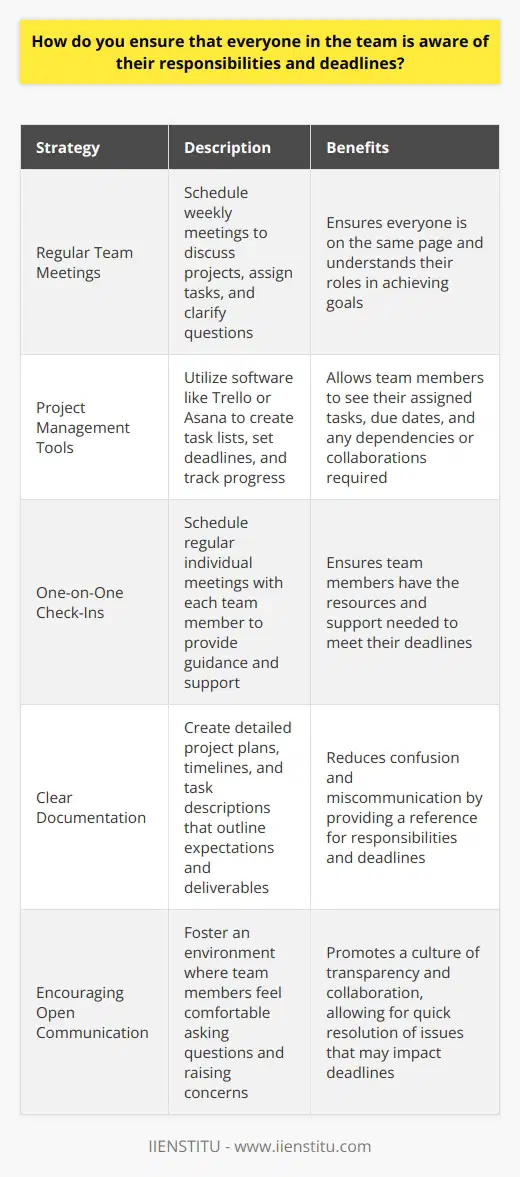
Can you describe your approach to creating and maintaining a project schedule in a collaborative environment?
When creating and maintaining a project schedule in a collaborative environment, I focus on open communication and flexibility. I start by breaking down the project into manageable tasks and setting realistic deadlines for each one.
Involving the Team
I involve the entire team in the scheduling process, gathering their input on task durations and dependencies. This helps ensure everyone is on the same page and feels ownership of the schedule.
Throughout the project, I maintain open lines of communication with the team. We have regular check-ins to discuss progress, identify any issues, and make adjustments as needed.
Staying Flexible
I've learned that flexibility is key when it comes to project schedules. Unexpected challenges can arise, and priorities can shift. I stay adaptable and willing to make changes to keep the project on track.
For example, on a recent website redesign project, we encountered some technical issues that set us back. I worked with the team to re-prioritize tasks and adjust the schedule accordingly. By staying flexible, we were still able to launch on time.
Using the Right Tools
I also believe in using the right tools to manage project schedules effectively. I'm a fan of collaboration software like Trello or Asana, which allow the whole team to view and update the schedule in real-time.
These tools help keep everyone accountable and ensure nothing falls through the cracks. They also make it easy to visualize the project timeline and spot potential roadblocks before they become major issues.
At the end of the day, creating and maintaining a project schedule is all about collaboration and adaptability. By involving the team, staying flexible, and using the right tools, I'm able to keep projects on track and deliver successful results.
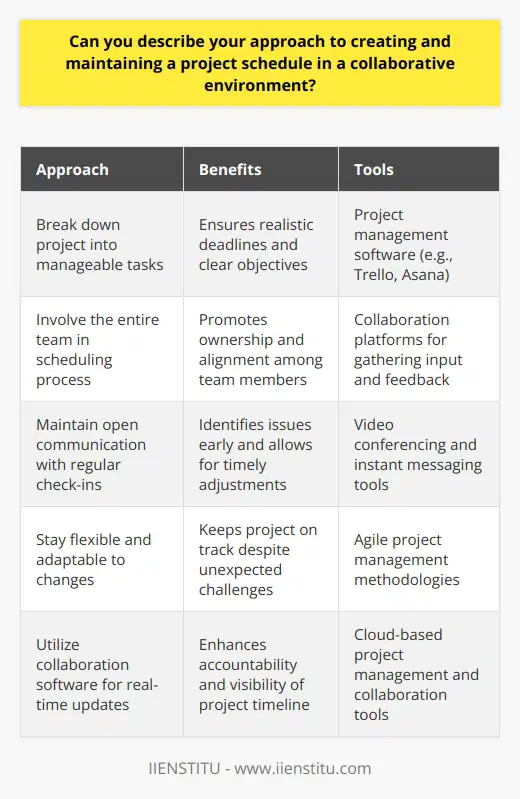
How do you handle unexpected delays or setbacks that affect the project timeline?
When faced with unexpected delays or setbacks that affect the project timeline, I take a proactive approach. First, I assess the situation and identify the root cause of the issue. Next, I communicate with stakeholders to keep them informed and manage expectations.
Developing a Plan of Action
Once I have a clear understanding of the problem, I work with my team to develop a plan of action. We brainstorm potential solutions and prioritize tasks based on their impact and urgency. I also consider alternative approaches that could help us get back on track.
Adapting and Being Flexible
I believe that adaptability is key when dealing with setbacks. I'm willing to adjust my approach and find creative solutions. In my previous role, we encountered a supply chain issue that threatened to derail our project. By thinking outside the box and sourcing materials from alternative suppliers, we were able to keep the project moving forward.
Staying Focused on the Goal
Throughout the process, I stay focused on the ultimate goal and keep my team motivated. I encourage open communication and collaboration, and I lead by example. By maintaining a positive attitude and a solutions-oriented mindset, I find that we can overcome most challenges.
Learning from Experience
Finally, I believe in learning from every experience, whether it's a success or a setback. I take the time to reflect on what worked well and what could be improved. By continuously learning and growing, I'm better equipped to handle future challenges and deliver successful projects.

What strategies do you use to keep yourself and your team members motivated and on track?
I believe that motivation and staying on track are crucial for the success of any team. Here are some strategies I use to keep myself and my team members motivated:
Lead by Example
I always strive to be a role model for my team. I maintain a positive attitude, even when faced with challenges. By demonstrating dedication and hard work, I inspire my team to do the same.
Set Clear Goals and Expectations
I work with my team to set clear, achievable goals. We break down larger objectives into smaller, manageable tasks. This helps us stay focused and motivated, as we can see our progress along the way.
Recognize and Celebrate Successes
I make a point to acknowledge and celebrate the successes of my team members. Whether it's a small win or a major milestone, I believe in recognizing hard work and dedication. This boosts morale and encourages everyone to keep pushing forward.
Foster Open Communication
I encourage open communication within my team. I create an environment where everyone feels comfortable sharing their ideas, concerns, and feedback. By fostering a culture of transparency and collaboration, we can work together more effectively and stay motivated.
Provide Support and Resources
I make sure my team has the support and resources they need to succeed. Whether it's additional training, tools, or guidance, I'm always there to help. By investing in my team's growth and development, I keep them engaged and motivated.
These are just a few of the strategies I use to keep myself and my team members motivated and on track. I believe that by leading with positivity, setting clear goals, celebrating successes, fostering open communication, and providing support, we can achieve great things together.
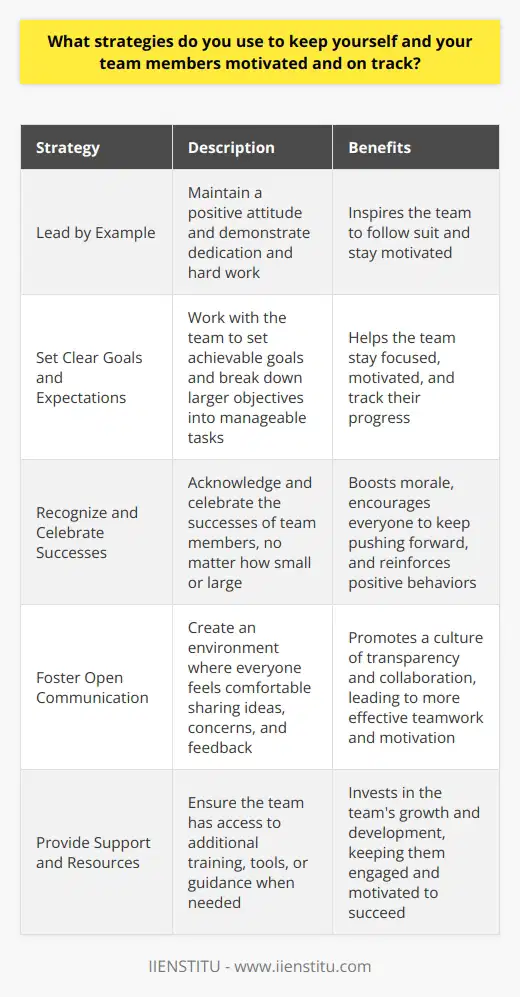
How do you prioritize your own tasks while also considering the needs of your team members?
When it comes to prioritizing tasks, I always start by considering the urgency and importance of each item. I look at deadlines, dependencies, and the potential impact on the team's goals. This helps me identify which tasks need immediate attention and which ones can wait.
Communicating with the Team
Next, I make sure to communicate regularly with my team members. I check in with them to understand their current workload, any challenges they're facing, and how I can support them. By staying connected, I can adjust my priorities as needed to ensure everyone has what they need to succeed.
Balancing Individual and Team Needs
It's important to strike a balance between my own responsibilities and the needs of the team. If a team member is struggling with a critical task, I'm always willing to step in and help, even if it means temporarily putting my own work on hold. At the same time, I make sure not to overcommit myself, as that could ultimately hinder the team's progress.
Staying Organized and Adaptable
To stay on top of everything, I rely on tools like project management software and shared calendars. These help me track deadlines, assign tasks, and ensure nothing falls through the cracks. However, I also remain flexible and ready to adapt when priorities shift or unexpected challenges arise.
Leading by Example
As a team member, I believe it's crucial to lead by example. I strive to be reliable, communicative, and supportive, setting a positive tone for the entire team. By demonstrating strong prioritization skills and a commitment to collaboration, I hope to inspire and motivate those around me.
At the end of the day, prioritizing tasks effectively is about understanding the big picture and being willing to make trade-offs when necessary. It's a skill I've developed through experience, and one that I continue to refine as I take on new challenges and work with different teams.

Can you give an example of a time when you had to adjust your time management approach in a collaborative project?
In my previous role as a marketing coordinator, I had to adjust my time management approach during a collaborative project with the sales team. We were working on a tight deadline to launch a new product, and I quickly realized that my usual time management strategy wouldn't work.
Identifying the Problem
I noticed that the sales team had different priorities and communication styles than I was used to. They often scheduled last-minute meetings or requested urgent changes, which disrupted my carefully planned schedule.
Adapting to the Team's Needs
To address this challenge, I decided to adapt my approach. I started by having an open conversation with the sales team lead about our different working styles and how we could find a middle ground.
We agreed on a few key changes:
The Results
By being proactive and willing to adapt, I was able to successfully collaborate with the sales team. We launched the new product on time, and even exceeded our initial sales targets.
This experience taught me the importance of being flexible and communicating openly in a collaborative project. It's not always easy, but finding a way to work together effectively is crucial for success.

How do you ensure that your team members have the resources and support they need to complete their tasks on time?
As a team leader, I prioritize open communication and regularly check in with my team members. During our one-on-one meetings, I actively listen to their concerns and proactively address any obstacles they face. I also encourage them to speak up if they need additional support or resources.
Setting Clear Expectations and Goals
I work closely with my team to establish clear goals and deadlines for each project. By breaking down large tasks into smaller, manageable steps, we can track progress and ensure everyone stays on schedule. I also make sure that each team member understands their role and responsibilities.
Providing Necessary Tools and Training
I advocate for my team to have access to the tools and software they need to work efficiently. If someone needs specific training or skills development, I work with them to find appropriate resources, such as online courses or mentorship opportunities within the company.
Fostering Collaboration and Support
I strive to create a collaborative and supportive team environment. I encourage team members to help each other out when needed and share their knowledge and expertise. If someone is struggling with a task, I step in to offer guidance or connect them with a colleague who can assist.
By staying attuned to my team's needs and proactively addressing any challenges, I ensure they have the resources and support to succeed. It's incredibly rewarding to see my team members grow, develop new skills, and consistently deliver high-quality work on time.
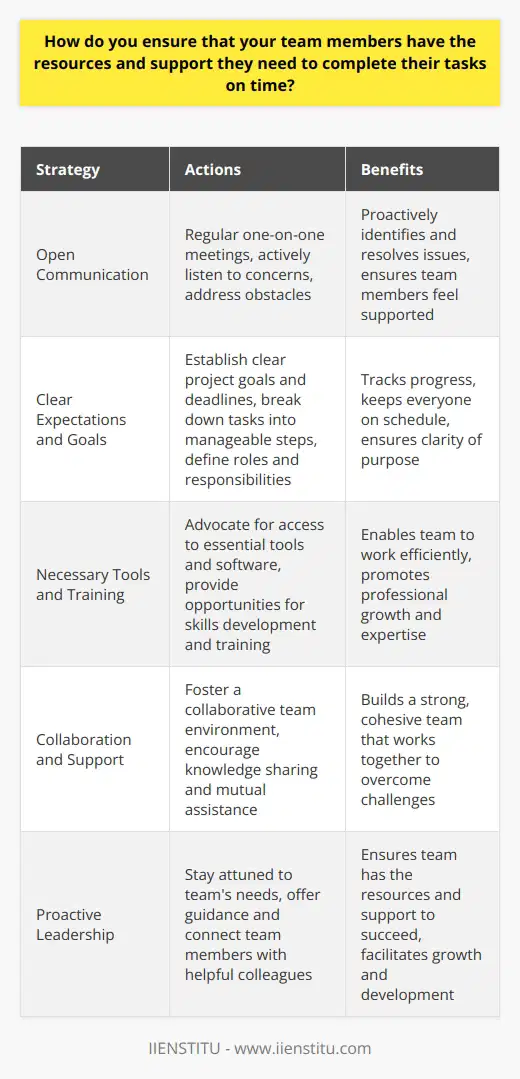
What techniques do you use to estimate the time required for each task in a collaborative project?
When estimating the time required for each task in a collaborative project, I rely on a few key techniques. First, I break down the project into smaller, manageable tasks. This allows me to assess the complexity and scope of each task more accurately.
Communication is Key
Next, I engage in open communication with my team members. We discuss our individual strengths, weaknesses, and workloads. This helps me understand how long each person might need to complete their assigned tasks. It's essential to be realistic and factor in potential roadblocks or delays.
Historical Data and Experience
Drawing from my previous experiences is also crucial. I look back at similar projects I've worked on and consider how long comparable tasks took to complete. While every project is unique, historical data can provide a solid foundation for time estimates.
Buffer Time for Unexpected Challenges
I always include some buffer time in my estimates. Unexpected challenges can arise, and it's better to be prepared. I typically add 10-20% extra time to account for these potential hurdles. This ensures that we have some wiggle room in our schedule.
Continuous Monitoring and Adjustment
Finally, I believe in continuous monitoring and adjustment. As the project progresses, I keep a close eye on our timeline. If tasks are taking longer than expected, I communicate with my team and make necessary adjustments. Flexibility is key to ensuring we meet our deadlines while maintaining quality work.
By using these techniques, I can provide accurate time estimates and keep our collaborative projects on track.
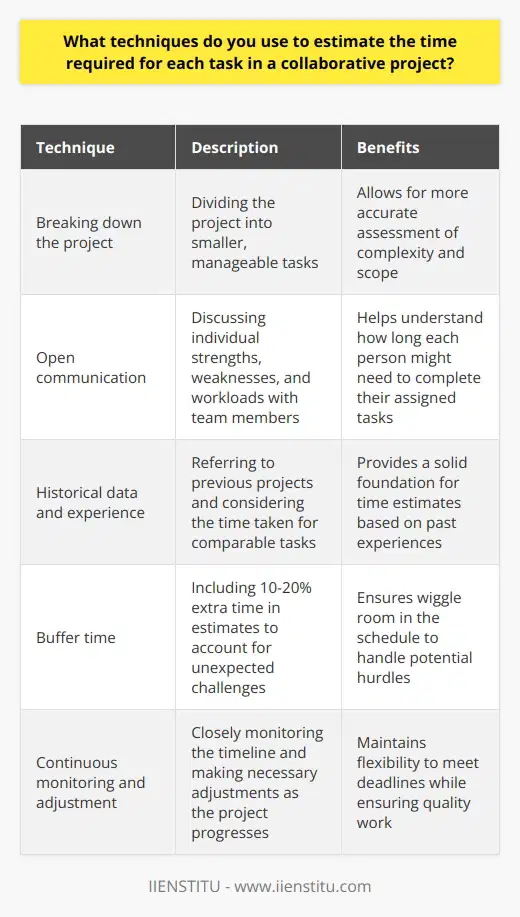
How do you handle situations where you or a team member are struggling to meet a deadline?
I handle deadline struggles by first assessing the situation objectively. I identify the roadblocks and bottlenecks causing the delay. Next, I prioritize tasks based on their importance and urgency. This helps me focus on what matters most.
Communicating with the Team
I believe in open and honest communication with my team. I discuss the challenges we're facing and brainstorm solutions together. Collaborating with colleagues often leads to innovative ideas that can get the project back on track.
Seeking Help and Resources
If the situation demands it, I'm not afraid to ask for help. I reach out to other departments or supervisors for additional resources or guidance. In my previous role, I once requested a temporary team member to assist with a tight deadline. This extra support allowed us to complete the project on time.
Keeping Stakeholders Informed
Throughout the process, I keep stakeholders informed about the progress and any adjustments to the timeline. I believe in managing expectations proactively. In my experience, clients appreciate transparency and are more understanding when kept in the loop.
Learning from Experience
After the project is complete, I conduct a retrospective with my team. We discuss what went well, what didn't, and what we can improve for future projects. I'm always looking for ways to optimize our processes and prevent similar struggles down the line.
Overall, I approach deadline challenges with a calm, solution-oriented mindset. I focus on what I can control and rally my team to find the best path forward.
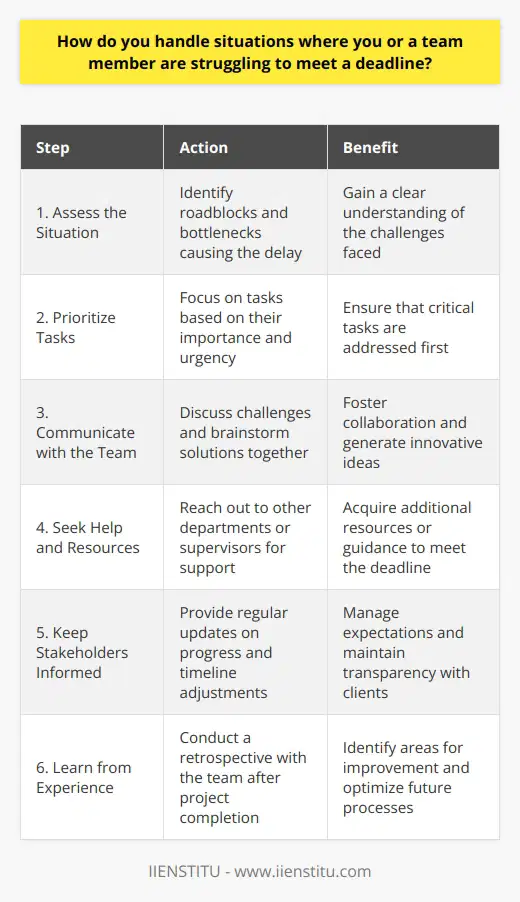
Can you describe a time when you had to make a difficult decision to prioritize one task over another in a team project?
In my previous role as a marketing coordinator, I faced a challenging situation where I had to prioritize tasks. Our team was working on a product launch campaign with a tight deadline.
Conflicting Priorities
I was responsible for creating promotional materials while also managing social media accounts. Suddenly, an urgent request came from the sales team for updated product brochures.
Assessing the Impact
I realized that delaying the brochures could negatively impact sales efforts. However, neglecting social media would decrease our online presence during the crucial launch period.
Making a Decision
After carefully considering the consequences, I decided to prioritize the brochures. I communicated my decision to the team and explained my reasoning.
Collaborating with Colleagues
To ensure social media wasn't entirely neglected, I reached out to a colleague for assistance. We divided the tasks, and I focused on the brochures while they handled social media.
Positive Outcome
By prioritizing the brochures, we provided the sales team with the necessary resources to succeed. Although I had to make a tough call, effective communication and collaboration allowed us to achieve our goals.
This experience taught me the importance of evaluating the impact of each task and making informed decisions to drive the best results for the company.
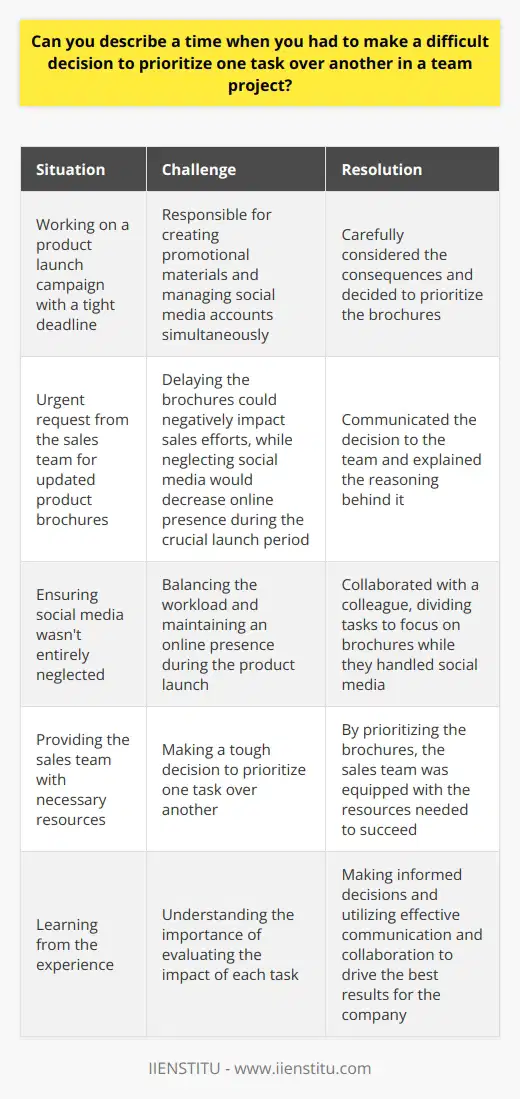
How do you ensure that your team members are not overloaded with tasks and can manage their time effectively?
As a team leader, I prioritize effective communication and regular check-ins with my team members. This allows me to stay informed about their workload and progress on tasks.
Setting clear expectations and deadlines
When assigning tasks, I provide clear instructions and realistic deadlines. I encourage open dialogue to ensure everyone understands their responsibilities and feels comfortable raising concerns.
In my previous role, I implemented a system where team members could flag if they were overloaded. This helped me redistribute work more evenly and prevent burnout.
Utilizing project management tools
I'm a big believer in using project management software to track tasks, deadlines, and workload. Tools like Trello or Asana provide visibility into what everyone is working on.
At my last company, introducing Trello transformed how we managed projects. It gave me a clear overview of capacity and allowed me to adjust assignments as needed.
Encouraging work-life balance
I lead by example in maintaining a healthy work-life balance. I avoid sending non-urgent emails outside work hours and encourage my team to disconnect and recharge.
When I notice someone regularly working long hours, I check in with them one-on-one. Together, we review their workload and identify areas where I can provide more support or resources.
By fostering a culture of open communication, leveraging productivity tools, and promoting work-life balance, I ensure my team can manage their time effectively without getting overwhelmed. I'm committed to supporting their wellbeing and success.
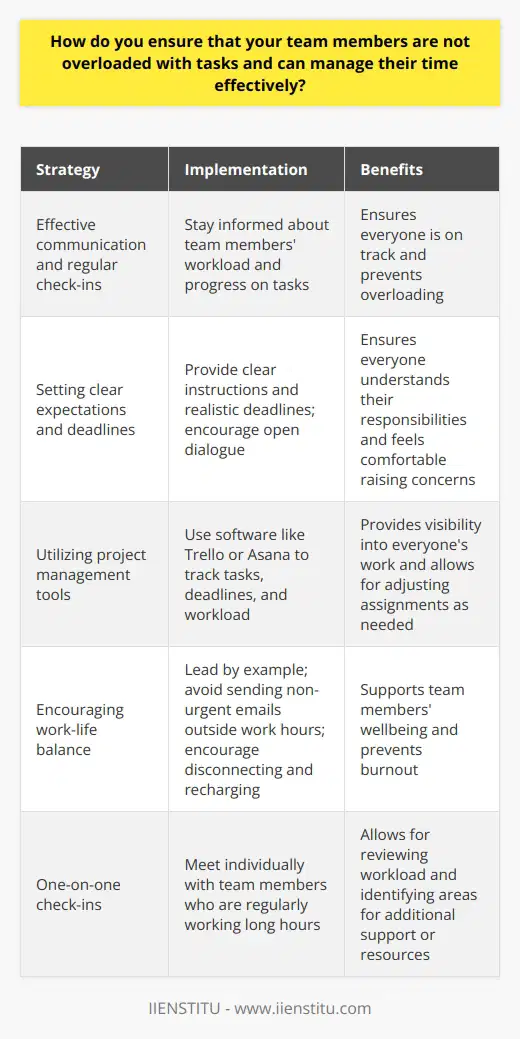
What strategies do you use to maintain a healthy work-life balance while working on collaborative projects with tight deadlines?
Maintaining a healthy work-life balance while collaborating on projects with tight deadlines is crucial for both personal well-being and professional success. Over the years, I've developed several strategies that help me strike this balance.
Prioritize and Plan
I start by breaking down the project into manageable tasks and prioritizing them based on urgency and importance. This helps me focus on the most critical aspects of the project first. I also set realistic goals for each day and week, ensuring that I allocate sufficient time for work, rest, and personal commitments.
Communicate Effectively
Open and honest communication with team members is key to managing expectations and avoiding burnout. I make sure to discuss my capacity, limitations, and any personal obligations that may impact my work. By being transparent, I can work with my team to find solutions and adjust timelines if needed.
Set Boundaries
I establish clear boundaries between work and personal life. When I'm working, I give my full attention to the project at hand. However, I also make sure to disconnect from work during my personal time. This means avoiding checking emails or taking work-related calls outside of designated hours, unless it's an emergency.
Practice Self-Care
Taking care of my physical and mental health is essential for maintaining a healthy work-life balance. I make time for activities that help me recharge, such as exercising, meditating, or pursuing hobbies. When I feel overwhelmed or stressed, I reach out to friends, family, or even a professional for support.
By implementing these strategies, I've been able to successfully collaborate on projects with tight deadlines while still maintaining a healthy work-life balance. It's an ongoing process that requires flexibility, adaptability, and a commitment to prioritizing both personal and professional well-being.
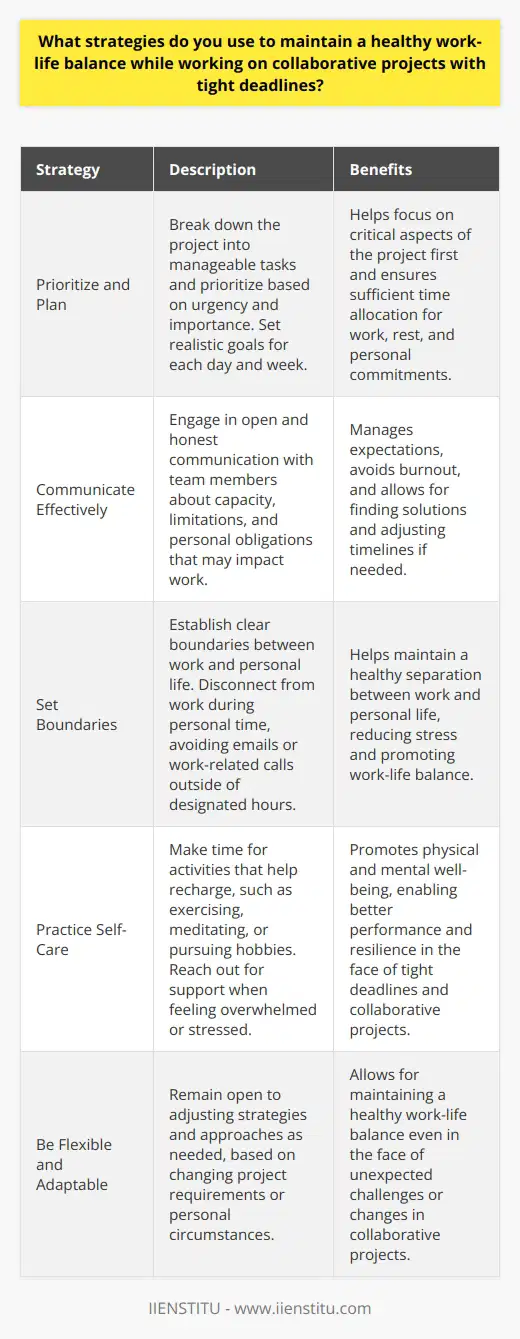
How do you handle disagreements among team members regarding task prioritization or timelines?
When disagreements arise among team members regarding task prioritization or timelines, I believe in taking a proactive approach. Open communication is key to resolving conflicts and finding common ground.
Listen to All Perspectives
I start by actively listening to each team member's concerns and opinions. Everyone should feel heard and valued. By understanding where each person is coming from, we can work towards a solution that addresses everyone's needs.
Identify Priorities and Goals
Next, I guide the team in clarifying our shared priorities and goals. What's most important for the project's success? When we focus on the big picture, it's easier to find alignment and make tough decisions.
Facilitate Collaborative Problem-Solving
I encourage the team to brainstorm solutions together. We look at the pros and cons of different approaches. I ask questions to help the group think creatively and find win-win options. Collaboration builds trust and buy-in.
Make Decisions Based on Facts and Logic
When it's time to make a decision, I rely on facts and logic rather than emotions. What do the data show? Which option best supports our goals and constraints? A rational approach helps everyone feel the process was fair.
Throughout the discussion, I maintain a calm and professional tone. I model active listening and respectful communication. By facilitating healthy dialogue, I aim to help the team reach consensus and move forward productively.
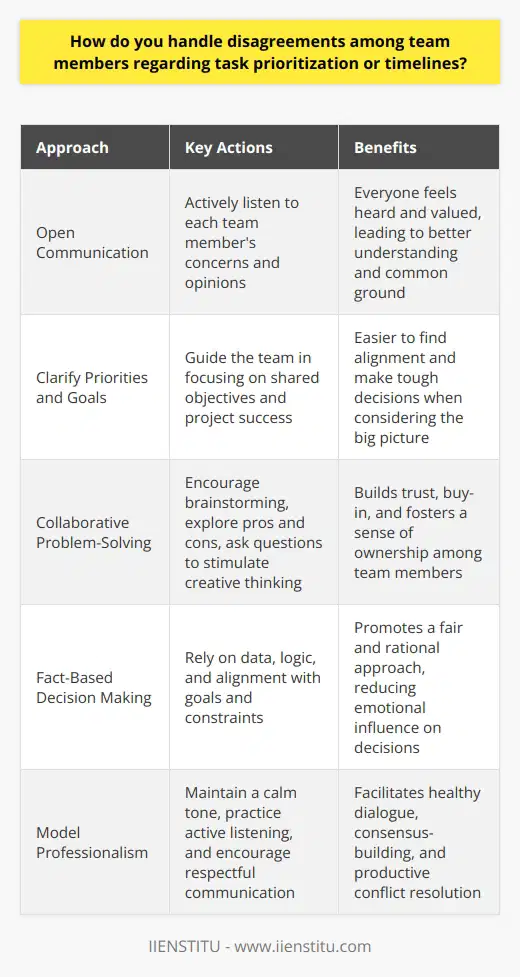
Can you give an example of how you have helped a team member improve their time management skills?
In my previous role as a project manager, I noticed that one of my team members was struggling with time management. They often missed deadlines and seemed overwhelmed by their workload.
Identifying the Problem
I scheduled a one-on-one meeting with them to discuss the issue. During our conversation, I listened attentively to their concerns and challenges. Together, we identified the root causes of their time management struggles.
Creating a Plan of Action
We collaboratively developed a plan to improve their time management skills. This included breaking down large tasks into smaller, manageable ones and prioritizing them based on urgency and importance.
I also introduced them to time-blocking techniques, where they dedicated specific time slots to focus on particular tasks without distractions. We set realistic deadlines and incorporated buffer time for unexpected issues.
Providing Support and Resources
Throughout the process, I regularly checked in with them to offer support and guidance. I shared productivity tools and resources that I found helpful in my own work, such as time-tracking apps and project management software.
I encouraged them to communicate openly about any challenges they faced and celebrated their progress along the way.
Seeing Results and Growth
Over time, I witnessed a significant improvement in their time management skills. They met deadlines more consistently and seemed more organized and in control of their workload.
What I found most rewarding was seeing their increased confidence and reduced stress levels. They expressed gratitude for the support and tools I provided, and I was proud to have played a role in their professional growth.
This experience taught me the importance of proactively addressing time management issues and providing individualized support to team members. It strengthened my leadership skills and my ability to foster a productive and supportive team environment.

How do you ensure that your team's time management practices align with the overall project goals and objectives?
As a team leader, I prioritize effective time management to ensure our efforts align with project goals. I start by clearly communicating objectives and deadlines to everyone involved. This helps us stay focused and motivated.
Breaking Down Tasks
I work with my team to break down large projects into smaller, manageable tasks. We assign realistic timeframes for each step, considering individual strengths and workloads. Regular check-ins help us stay on track and address any challenges promptly.
Encouraging Open Communication
I believe in fostering an environment where team members feel comfortable sharing their progress and concerns. We have weekly meetings to discuss our successes, roadblocks, and ways to optimize our time. This open dialogue allows us to adapt quickly and support each other.
Leading by Example
As a leader, I strive to model good time management habits. I prioritize tasks, minimize distractions, and meet my own deadlines consistently. By demonstrating these behaviors, I inspire my team to do the same. We celebrate our achievements together and learn from our missteps.
Leveraging Tools and Technology
I'm always looking for ways to streamline our processes and maximize efficiency. We use project management software to track progress, collaborate, and meet milestones. These tools provide visibility and accountability, ensuring we're all working towards the same goals.
Ultimately, effective time management is a team effort. By setting clear expectations, fostering open communication, and leading by example, I help my team stay focused on what matters most - delivering high-quality work that drives our project's success.

What methods do you use to track and report progress to stakeholders in a collaborative project?
When collaborating on a project, I use various methods to track progress and keep stakeholders informed. I'll share a few key strategies that have proven effective in my experience.
Regular check-ins and status updates
I schedule frequent check-ins with team members to discuss progress, challenges, and next steps. This helps me stay on top of developments and ensures everyone is aligned. I also send regular status updates to stakeholders, highlighting key milestones, risks, and decisions.
Project management tools
I'm a big fan of using project management software like Trello or Asana to organize tasks, deadlines, and dependencies. These tools provide a clear overview of the project's progress and allow for easy collaboration and communication among team members. I can quickly generate reports from these platforms to share with stakeholders.
Visual progress tracking
In addition to detailed reports, I find that visual aids like Gantt charts or progress bars help convey project status at a glance. I create and update these visuals regularly, making it easy for stakeholders to understand where we stand without getting lost in the details.
Proactive communication
I believe in proactive communication when it comes to project progress. I don't wait for stakeholders to ask for updates; instead, I keep them informed at regular intervals. If there are any issues or delays, I notify them immediately and propose solutions. By staying one step ahead, I build trust and confidence with stakeholders.
Tracking and reporting progress is crucial for successful project collaboration. By using a combination of regular check-ins, project management tools, visual aids, and proactive communication, I ensure that stakeholders are always informed and the project stays on track.

How do you handle situations where external factors impact the project timeline, and how do you communicate this to your team?
When external factors impact a project timeline, I take a proactive approach to minimize the consequences. I assess the situation objectively and identify the root causes of the delay. Then, I develop a contingency plan with specific actions to mitigate the impact.
Transparent Communication
I believe in open and honest communication with my team. I explain the challenges we face and the revised timeline. I listen to their concerns and ideas, and we work together to find solutions. Regular updates keep everyone informed and engaged.
Prioritizing Tasks
When timelines shift, I prioritize tasks based on their criticality and dependencies. I focus on delivering the most essential features first. This ensures that we can still provide value to our clients, even if the full scope is delayed.
Managing Expectations
I proactively communicate with stakeholders about the impact of external factors. I explain the reasons for the delay and present our mitigation plan. By setting realistic expectations and providing regular progress reports, I maintain trust and confidence.
In my experience, a construction project faced permit delays due to a change in regulations. I worked closely with the authorities to expedite the process. I updated our plans and communicated the revised timeline to our client. By being transparent and proactive, we minimized the impact and delivered a successful project.
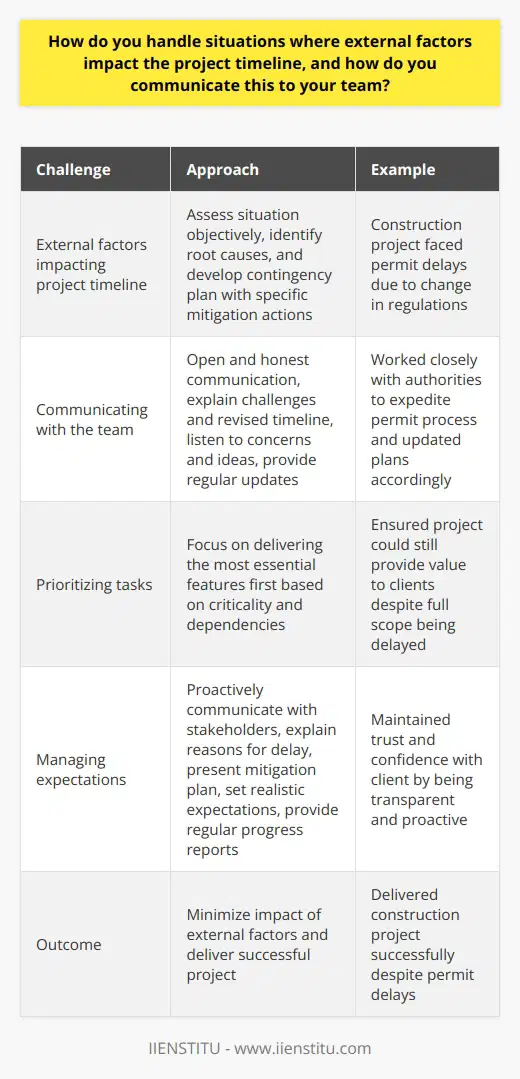
Can you describe a time when you had to be flexible and adapt your time management approach in a collaborative project?
In my previous role as a marketing coordinator, I had to be flexible and adapt my time management approach during a collaborative project with the sales team. We were working on a tight deadline to launch a new product campaign, and unexpected challenges arose along the way.
Prioritizing Tasks and Communicating Effectively
To ensure the project stayed on track, I had to quickly reassess my priorities and adjust my schedule. I communicated openly with my team members, keeping them informed of my progress and any obstacles I encountered. By being transparent and proactive in my communication, we were able to work together more efficiently and support each other when needed.
Adapting to Changing Circumstances
As the project evolved, I realized that some of my initial time estimates were off. Rather than stubbornly sticking to my original plan, I remained flexible and made necessary adjustments. This meant putting in extra hours when needed and being willing to shift my focus to more pressing tasks.
Leveraging Technology and Delegation
To streamline my workflow, I utilized project management tools like Trello and Asana. These platforms helped me stay organized and on top of my responsibilities. Additionally, I wasn't afraid to delegate tasks to other team members when appropriate, trusting in their abilities and expertise.
In the end, by being flexible and adaptable in my time management approach, we successfully launched the product campaign on schedule. This experience taught me the importance of being agile and responsive in collaborative projects, as well as the value of effective communication and teamwork.
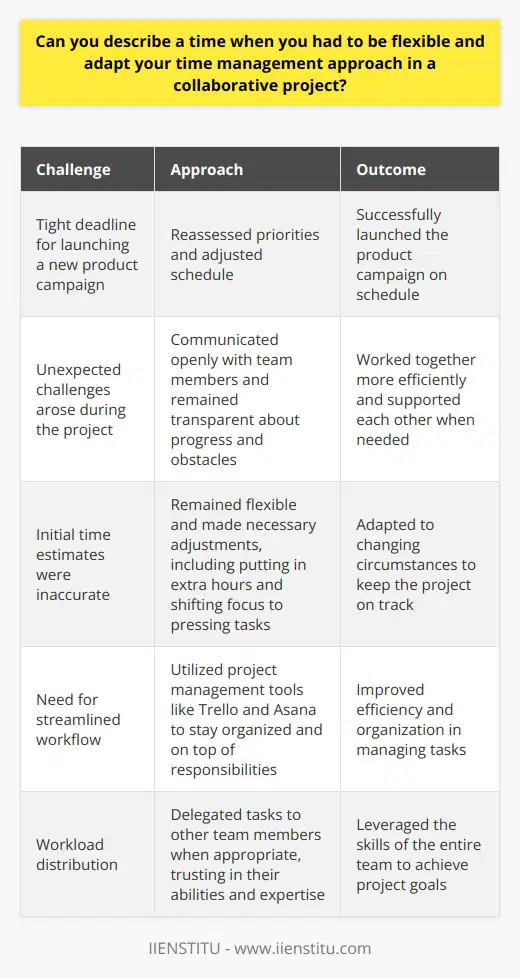
How do you ensure that your team members are aware of any changes to the project timeline or priorities?
As a team leader, I understand the importance of keeping everyone informed about project changes. Here are some strategies I use to ensure my team stays up-to-date:
Regular Team Meetings
I hold weekly team meetings where we discuss project progress, challenges, and any timeline or priority adjustments. This gives everyone a chance to ask questions and provide feedback.
During these meetings, I encourage open communication and collaboration. I want my team to feel comfortable sharing their thoughts and concerns.
Email Updates
After each meeting, I send out a brief email summary highlighting the key points discussed. This helps reinforce the information and provides a written record for future reference.
If there are any significant changes between meetings, I send an email update to the team right away. I believe in being proactive and transparent with communication.
One-on-One Check-Ins
In addition to team meetings, I schedule regular one-on-one check-ins with each team member. These sessions allow me to provide individual guidance and support.
During these check-ins, I make sure each person understands their role and responsibilities, especially if priorities have shifted. I also use this time to address any personal concerns or challenges.
Project Management Tools
I utilize project management software to create a centralized hub for all project-related information. This includes timelines, task assignments, and progress updates.
Team members can access this platform anytime to view the latest project details. I encourage everyone to regularly check and update their tasks to maintain transparency.
By implementing these strategies, I aim to foster a culture of open communication and collaboration within my team. Keeping everyone informed and engaged is crucial to the success of any project.
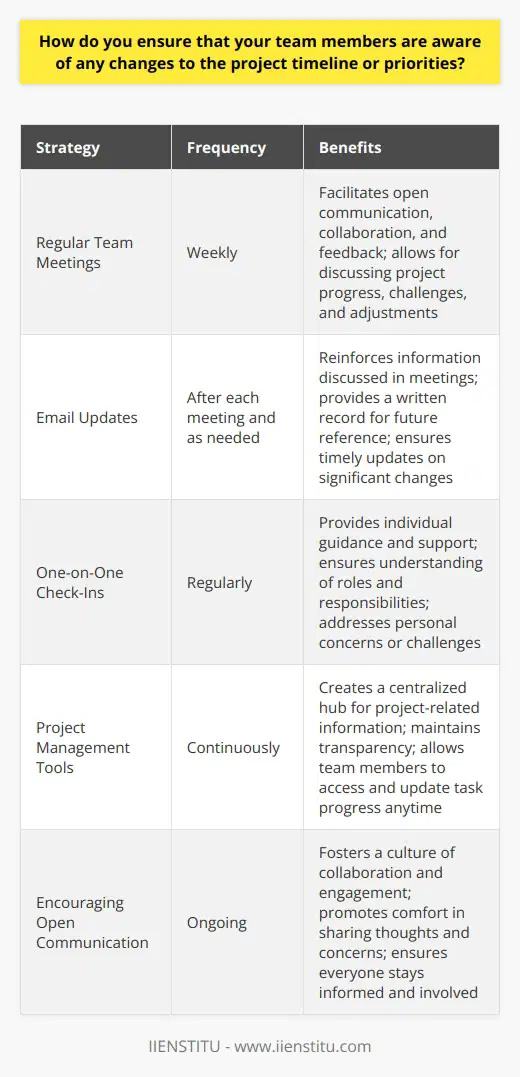
What strategies do you use to celebrate successes and milestones with your team while still maintaining focus on the remaining tasks?
Celebrating Successes and Milestones
When my team reaches a milestone or achieves success, I believe it's crucial to acknowledge and celebrate together. Whether it's a small gathering or a fun team-building activity, taking a moment to recognize hard work boosts morale. I remember when we completed a challenging project last year, we went out for lunch and shared stories about overcoming obstacles. It brought us closer and motivated us for the next challenge.
Maintaining Focus on Remaining Tasks
While celebrations are important, I also understand the need to quickly refocus on the tasks ahead. I usually schedule a brief team meeting after a celebration to discuss our next steps and priorities. This helps us transition smoothly back into work mode. Setting clear goals and deadlines ensures we maintain momentum without losing sight of our objectives.
Balancing Celebration and Productivity
Ultimately, the key is finding a balance between celebrating successes and maintaining productivity. I strive to create a positive team culture that values both achievements and continuous improvement. By openly communicating, supporting one another, and staying adaptable, we can enjoy our victories while tackling new challenges head-on. It's an approach that has served me well in my career, and I believe it would contribute to the success of your company as well.
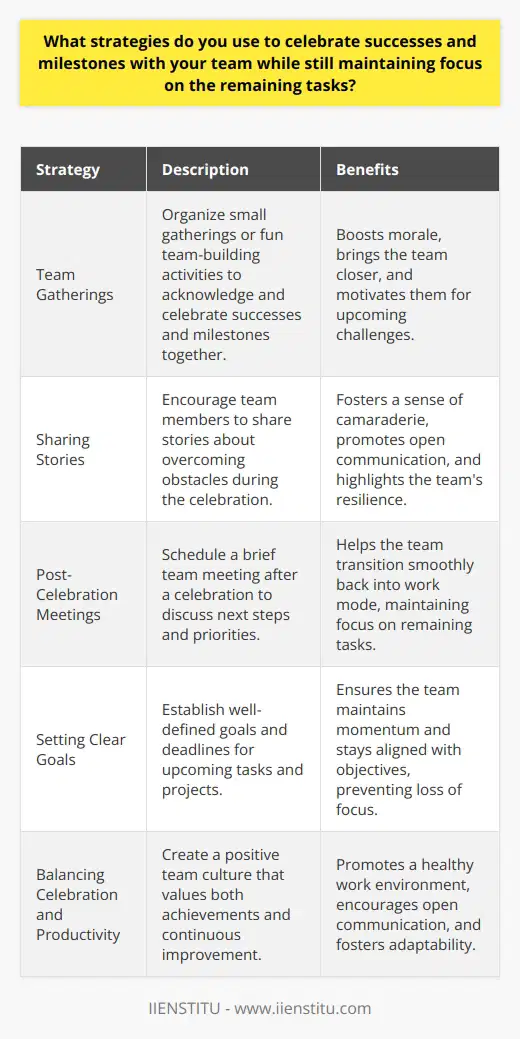
How do you continuously improve your time management skills and those of your team members in collaborative projects?
I continuously improve my time management skills and those of my team members through several strategies. Firstly, I prioritize tasks based on their importance and urgency. This helps me focus on what matters most and avoid wasting time on less critical activities.
Setting Clear Goals and Deadlines
I work with my team to set clear goals and deadlines for each project. We break down larger tasks into smaller, manageable steps with specific due dates. This approach keeps everyone on track and accountable for their responsibilities.
Regular Check-Ins and Progress Updates
I schedule regular check-ins with my team members to discuss progress, challenges, and any support they need. These meetings help identify potential roadblocks early on and allow us to adjust our plans accordingly. We also use collaborative tools like Trello and Slack to keep everyone informed and aligned.
Encouraging Open Communication and Feedback
I foster an environment of open communication and feedback within my team. We share tips and strategies for managing our time effectively and offer constructive feedback to help each other improve. By learning from one another's experiences, we continuously refine our time management skills.
Embracing Flexibility and Adaptability
I recognize that unexpected challenges can arise in any project. Therefore, I encourage my team to be flexible and adaptable in their approach to time management. We regularly reassess our priorities and adjust our plans as needed to ensure we stay on track and deliver high-quality results.
By implementing these strategies consistently, I've seen significant improvements in my own time management abilities and those of my team members. It's an ongoing process of learning, refining, and adapting, but the results are well worth the effort.
